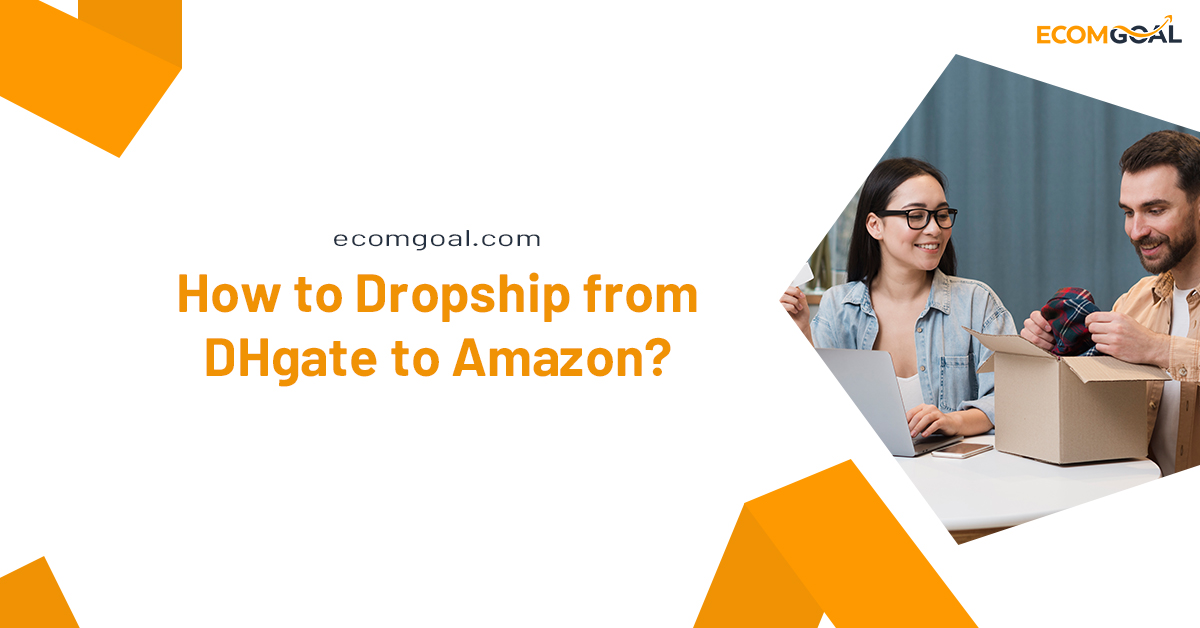
Dropshipping has become a popular e-commerce business model due to its low startup costs and minimal inventory requirements. One of the most commonly used platforms for sourcing products is DHgate, a Chinese e-commerce platform that connects small and medium-sized businesses with buyers around the world. By dropshipping products from DHgate to Amazon, you can run a successful online business without having to hold inventory or manage shipping logistics. However, this process comes with its own set of challenges & considerations.
In this comprehensive guide, we’ll walk you through the steps of how to Dropship from DHgate to Amazon, covering everything from finding the right products to navigating Amazon’s policies. By the end of this guide, you’ll have a clear understanding of how to start and grow a profitable dropshipping business using these two platforms.
What is Dropshipping?
Before diving into the specifics of dropshipping from DHgate to Amazon, let’s briefly review the dropshipping business model. Dropshipping is a retail fulfillment system where the seller doesn’t keep the products in stock. Instead, when a customer places an order, the seller purchases the product from a third party—usually a wholesaler or manufacturer—who then ships it directly to the customer.
Advantages of Dropshipping
- Low Startup Costs: You don’t need to invest in inventory, which significantly reduces upfront costs.
- Flexibility: You can run your business from any place with an internet connection.
- Wide Product Range: Since you don’t have to pre-purchase inventory, you can offer a broader range of products.
Disadvantages of Dropshipping
- Lower Profit Margins: Since you’re not buying in bulk, your cost per item may be higher, reducing your profit margins.
- Lack of Control: You rely on the supplier for product quality, packaging, and shipping, which can affect customer satisfaction.
- Inventory Issues: Since you don’t control the inventory, there’s a risk that the products you’re selling may go out of stock without notice.
How to Dropship from DHgate to Amazon Step-by-Step Guide
Why Choose DHgate for Dropshipping?
DHgate is one of the largest online wholesale marketplaces in China, offering a vast range of products at competitive prices. It’s a popular choice for dropshippers due to its variety of products, supplier reliability, and ease of use.
Benefits of Using DHgate for Dropshipping
- Wide Product Selection: DHgate offers millions of products across various categories, from electronics to fashion.
- Competitive Pricing: The platform allows you to source products at low prices, which can help you achieve better profit margins.
- Supplier Verification: DHgate verifies its suppliers, which reduces the risk of fraud and ensures a level of reliability.
- Flexible Payment Options: DHgate supports multiple payment methods, including PayPal, credit cards, and bank transfers.
Challenges of Using DHgate for Dropshipping
- Shipping Times: Since most suppliers are based in China, shipping times to the U.S. or Europe can be lengthy.
- Communication Barriers: Language differences and time zones can make communication with suppliers challenging.
- Quality Control: Product quality can vary between suppliers, so it’s crucial to vet suppliers carefully.
Setting Up Your Amazon Seller Account
Before you can start dropshipping from DHgate to Amazon, you’ll need to set up an Amazon Seller Account. Amazon offers two types of seller accounts: Individual & Professional. The Individual plan is suitable for those who plan to sell fewer than 40 items per month, while the Professional plan is better for those who anticipate selling more than 40 items per month.
Steps to establish an Amazon Seller Account
- Choose Your Selling Plan: Decide whether the Individual or Professional plan is right for you. The Professional plan costs $39.99 per month, while the Individual plan has no monthly fee but charges $0.99 per item sold.
- Register for an Account: Go to Amazon Seller Central and follow the registration process. You’ll need to provide your business information, including your legal name, address, and tax identification number.
- Set Up Your Seller Profile: Once your account is approved, set up your seller profile, including your business name, logo, and store description.
- Understand Amazon’s Policies: Familiarize yourself with Amazon’s policies, particularly those related to dropshipping, to ensure you comply with their rules.
Finding the Right Products to Dropship
Product selection is a critical factor in the success of your dropshipping business. The right product can lead to high sales volumes and healthy profit margins, while the wrong product can result in low sales and customer complaints.
Product Research on DHgate
- Use DHgate’s Search Tools: Start by searching for products within your niche. Use DHgate’s search filters to narrow down your options based on price, minimum order quantity, and supplier rating.
- Analyze Market Demand: Use tools like Google Trends, Amazon Best Sellers, and Jungle Scout to assess the demand for your chosen products on Amazon.
- Check Supplier Reliability: Review the supplier’s ratings, customer reviews, and transaction history to ensure they are reliable and provide high-quality products.
- Sample the Products: If possible, order samples of the products you’re interested in selling to evaluate their quality before listing them on Amazon.
Criteria for Choosing Products
When selecting products to dropship from DHgate to Amazon, consider the following criteria:
- Profit Margin: Ensure there’s enough margin between the cost of the product (including shipping) and the price you can sell it for on Amazon.
- Shipping Time: Choose products that can be shipped relatively quickly to your target market. Lengthy shipping times can lead to customer dissatisfaction.
- Quality: Focus on products with high-quality materials and craftsmanship to minimize returns and negative reviews.
- Competition: Avoid overly saturated markets where it may be difficult to compete on price or quality.
Listing Products on Amazon
Once you’ve selected your products, the next step is to list them on Amazon. A well-optimized product listing is essential for attracting customers and driving sales.
Creating an Optimized Product Listing
- Product Title: Use a clear & descriptive title that includes relevant keywords. The title should highlight the main features and benefits of the product.
- Product Images: Use high-quality images that view the product from multiple angles. If possible, include lifestyle images that demonstrate the product in use.
- Product Description: Write a compelling product description that highlights the benefits, features, and unique selling points of the product. Use bullet points to create the description easy to read.
- Keywords: Use Amazon’s keyword research tools to identify relevant keywords and incorporate them into your title, description, and backend search terms.
- Pricing: Set a competitive price based on your cost, Amazon’s fees, and the prices of similar products on the platform.
Complying with Amazon’s Policies
Amazon has strict policies regarding dropshipping, and it’s essential to comply with them to avoid account suspension. Some key points to keep in mind comprise:
- You Must Be the Seller of Record: This means that you are responsible for everything related to the order, including customer service, returns, and refunds.
- No Third-Party Shipping Labels: The product must not include any third-party shipping labels, packing slips, or invoices.
- Product Quality: You are responsible for ensuring that the products you sell meet Amazon’s quality standards.
Fulfilling Orders from DHgate to Amazon Customers
When a customer places an order on Amazon, you’ll need to fulfill it by purchasing the product from your DHgate supplier and having it shipped directly to the customer. This process requires careful coordination to ensure timely delivery and customer satisfaction.
Order Fulfillment Process
- Place the Order on DHgate: After receiving an order on Amazon, place the corresponding order on DHgate using the customer’s shipping address.
- Monitor the Order: Keep track of the order status and communicate with the supplier if there are any delays or issues.
- Provide Tracking Information: Once the supplier ships the product, obtain the tracking number and provide it to your Amazon customer.
- Handle Customer Service: Be prepared to handle any customer inquiries or issues, such as delayed shipments or product defects.
Managing Returns and Refunds
Returns & refunds are an inevitable part of any e-commerce business. When dropshipping from DHgate to Amazon, managing returns can be more complicated due to the involvement of a third-party supplier.
- Understand DHgate’s Return Policy: Before listing a product, familiarize yourself with the supplier’s return policy on DHgate. Some suppliers may accept returns, while others may not.
- Create a Clear Return Policy: Set up a clear return policy on your Amazon store that aligns with both Amazon’s and your supplier’s policies.
- Coordinate Returns: If a customer requests a return, coordinate with your DHgate supplier to arrange for the return or replacement of the product.
- Issue Refunds Promptly: Ensure that refunds are issued promptly to maintain customer satisfaction and comply with Amazon’s policies.
Scaling Your Dropshipping Business
Once you’ve established your dropshipping business and are generating consistent sales, it’s time to consider scaling your operations. Scaling can involve expanding your product range, optimizing your processes, and increasing your marketing efforts.
Expanding Your Product Range
- Identify Top-Selling Products: Analyze your sales data to identify top-selling products and consider expanding your range with similar or complementary items.
- Explore New Niches: Research new niches and product categories that align with your brand and target audience.
- Diversify Suppliers: Consider working with multiple suppliers on DHgate to reduce the risk of stock shortages and to access a wider range of products.
Optimizing Your Operations
- Automate Order Processing: Use automation tools to streamline order processing and reduce manual work. This can help you save time and reduce errors.
- Improve Customer Service: Invest in tools and resources to improve your customer service, such as chatbots, CRM systems, and dedicated support staff.
- Optimize Product Listings: Continuously optimize your product listings by updating keywords, improving images, and refining descriptions based on customer feedback.
Increasing Marketing Efforts
- Amazon Advertising: Use Amazon’s advertising tools, such as Sponsored Products and Sponsored Brands, to increase the visibility of your listings and drive more traffic.
- Social Media Marketing: Leverage social media platforms to promote your products & engage with your target audience.
- Email Marketing: Build an email list of customers and potential customers, and use email marketing campaigns to drive repeat business and promote new products.
Conclusion
How to Dropship from DHgate to Amazon offers a lucrative opportunity to build a profitable e-commerce business with minimal upfront investment. By carefully selecting products, complying with Amazon’s policies, and optimizing your operations, you can create a successful dropshipping business that scales over time.
Remember that success in dropshipping requires dedication, continuous learning, & adaptability. The e-commerce landscape is constantly evolving, and staying informed about industry trends and best practices will help you stay ahead of the competition. With the right strategy and commitment, you can turn your dropshipping business into a thriving online enterprise.

Hello, I am an E-commerce Expert with extensive experience providing services to numerous e-commerce brands and individuals since 2017. My primary areas of expertise include the Amazon, Walmart, and Shopify marketplaces. Linkedin
